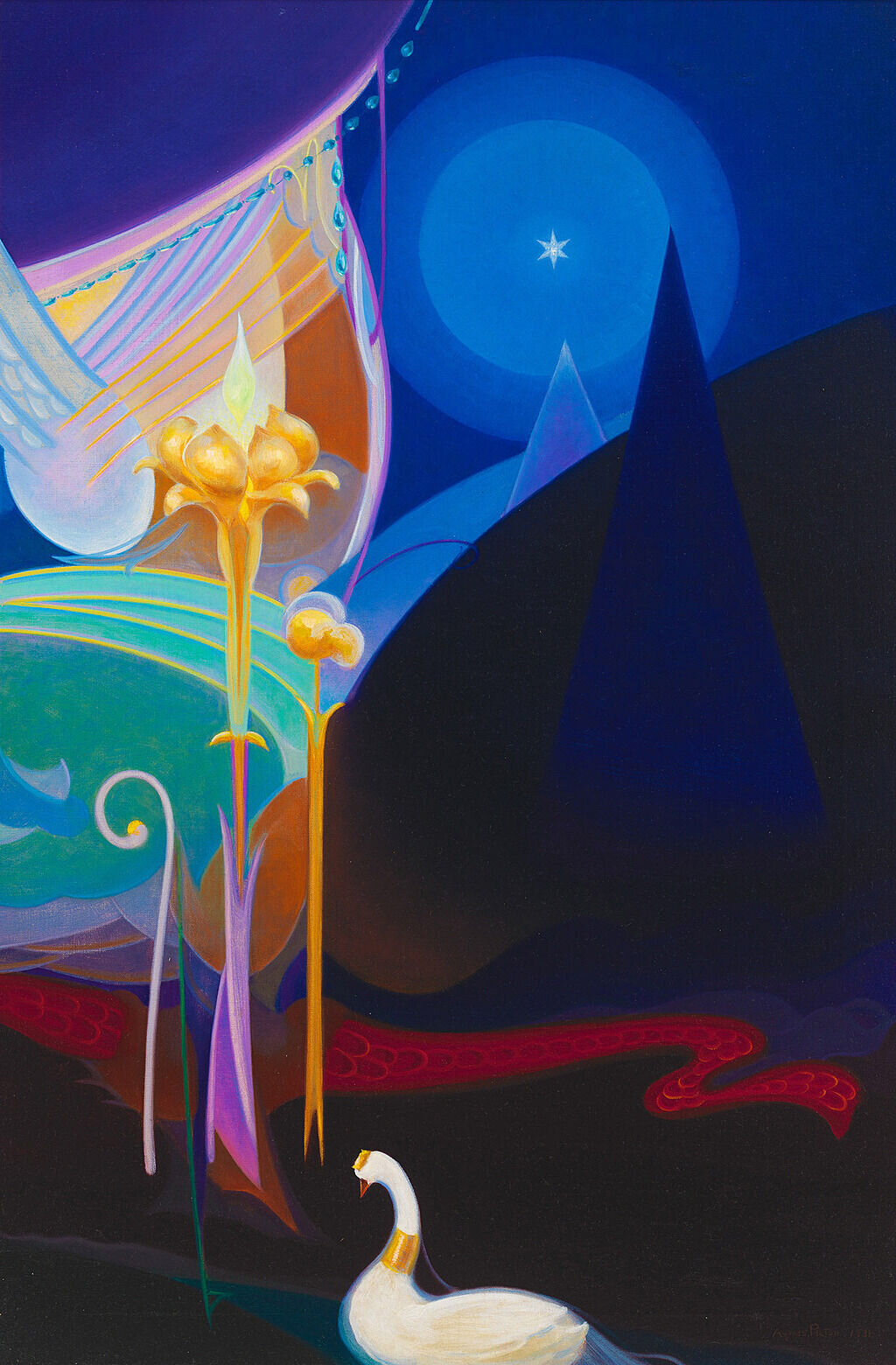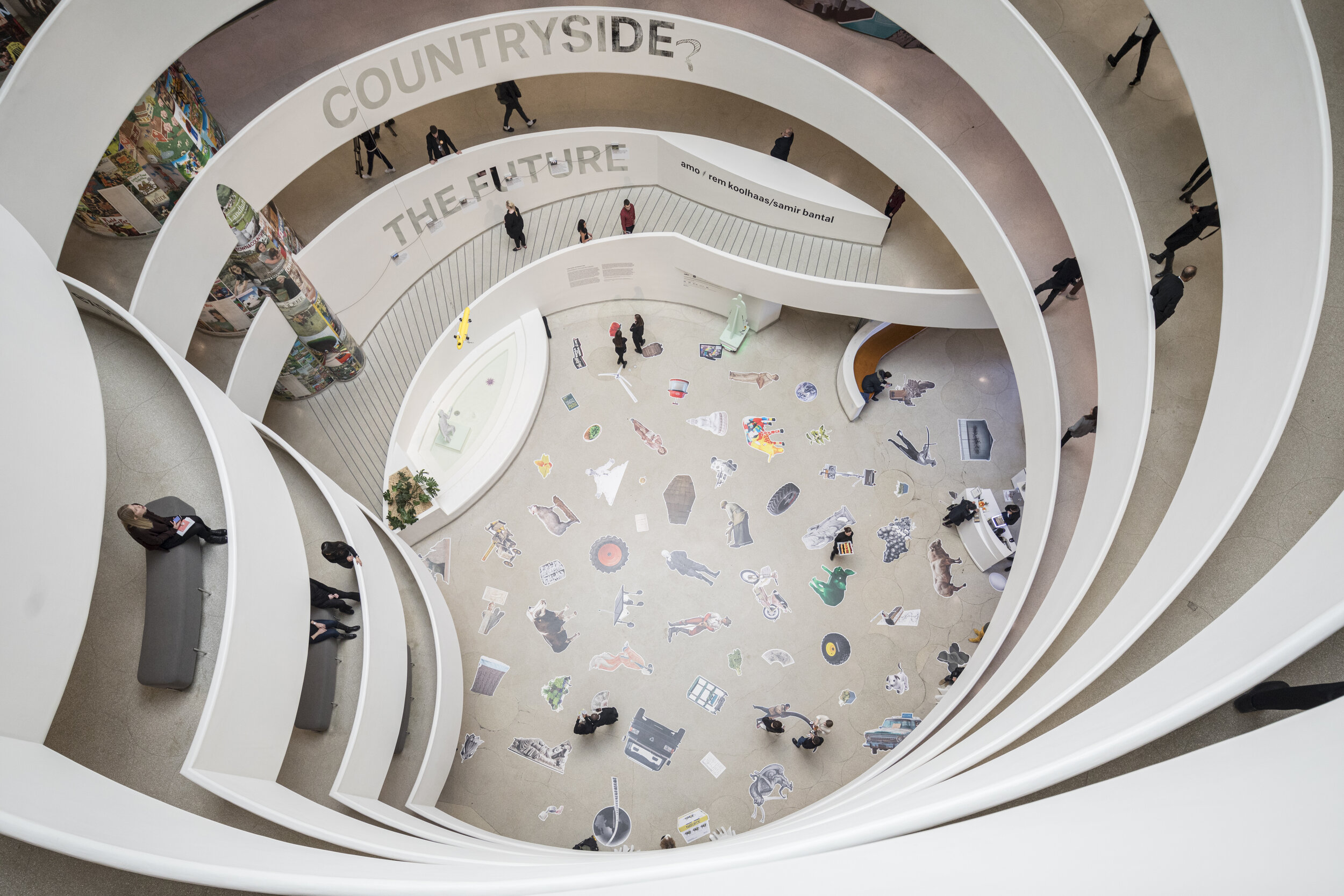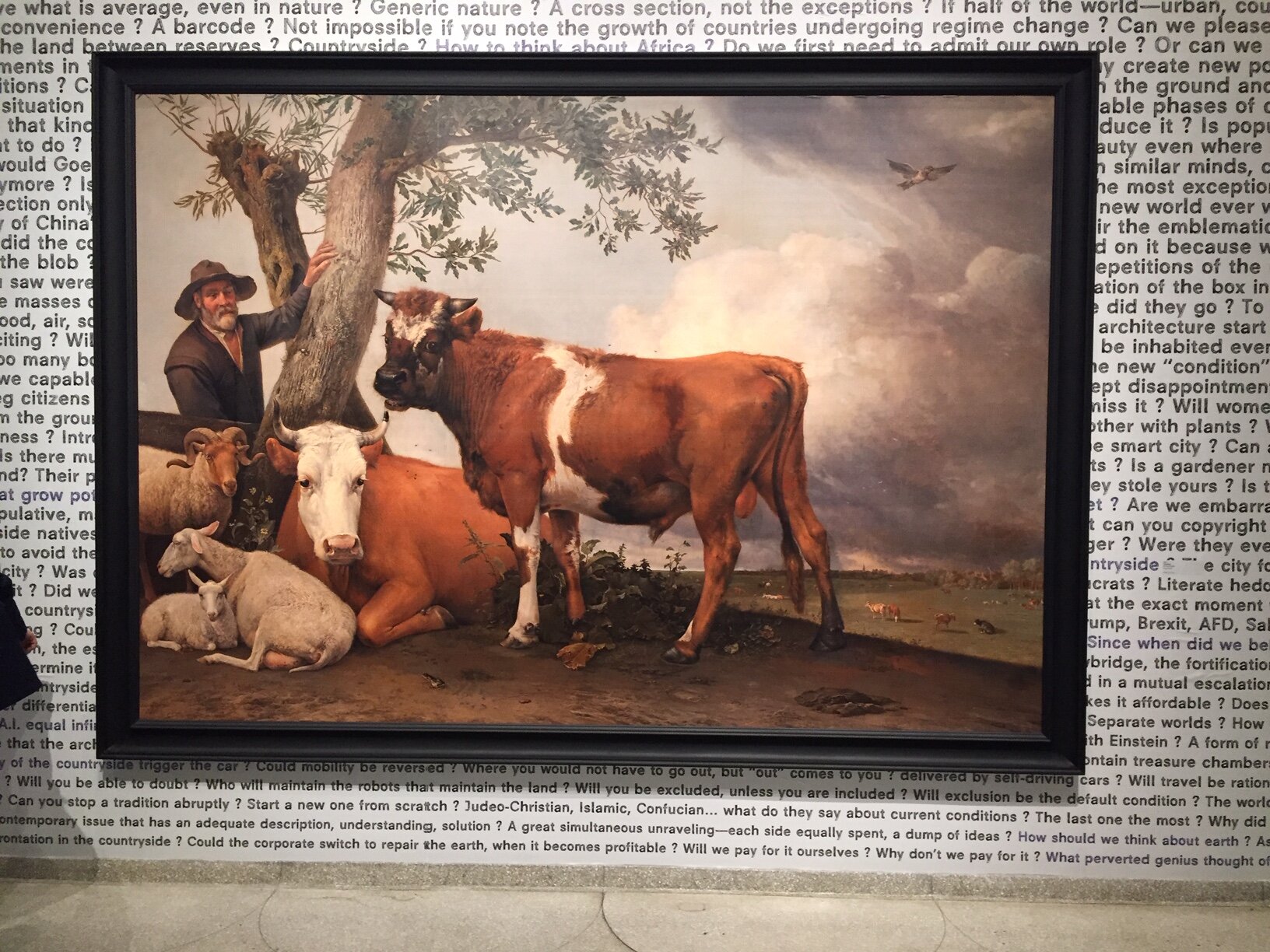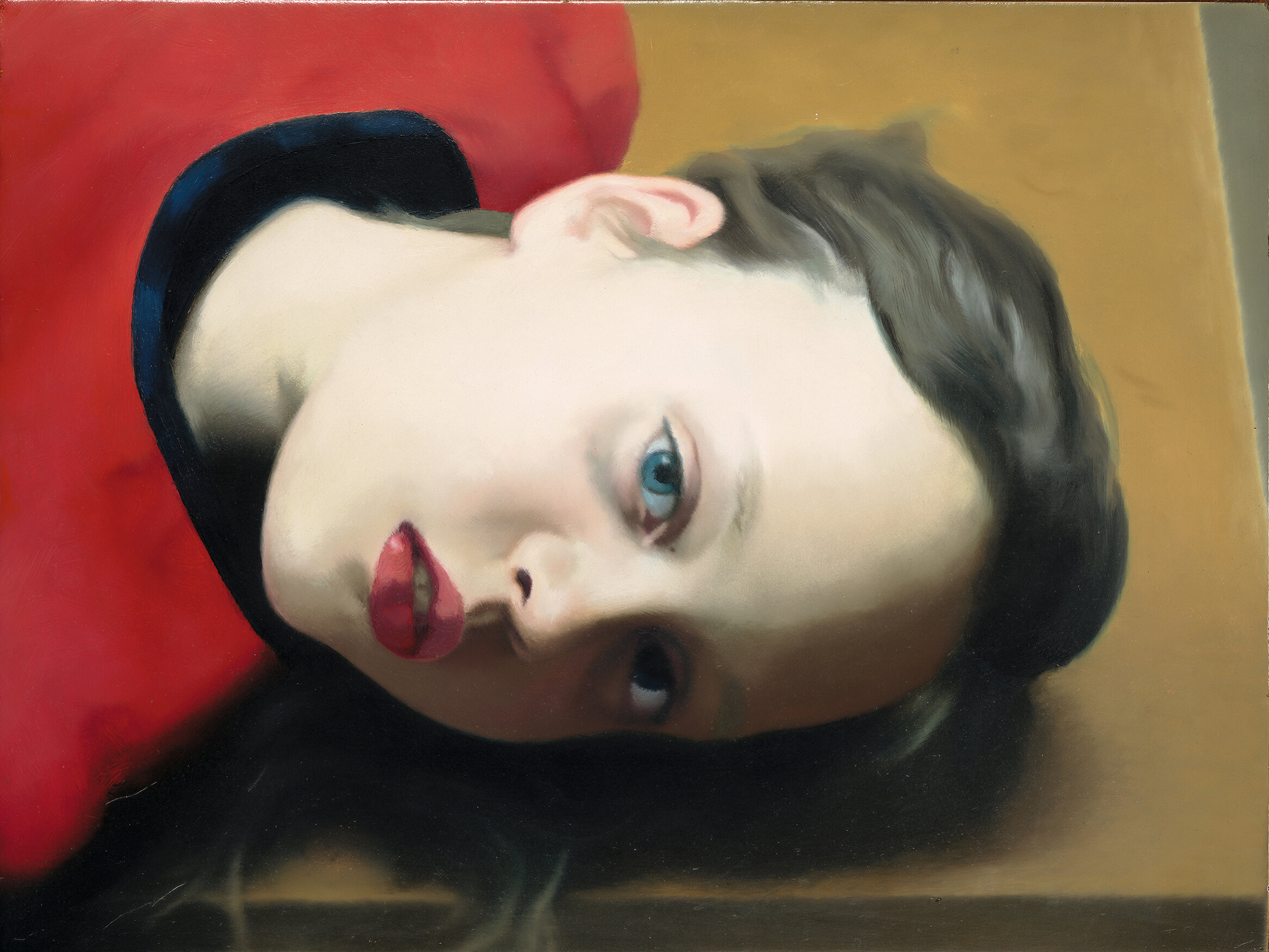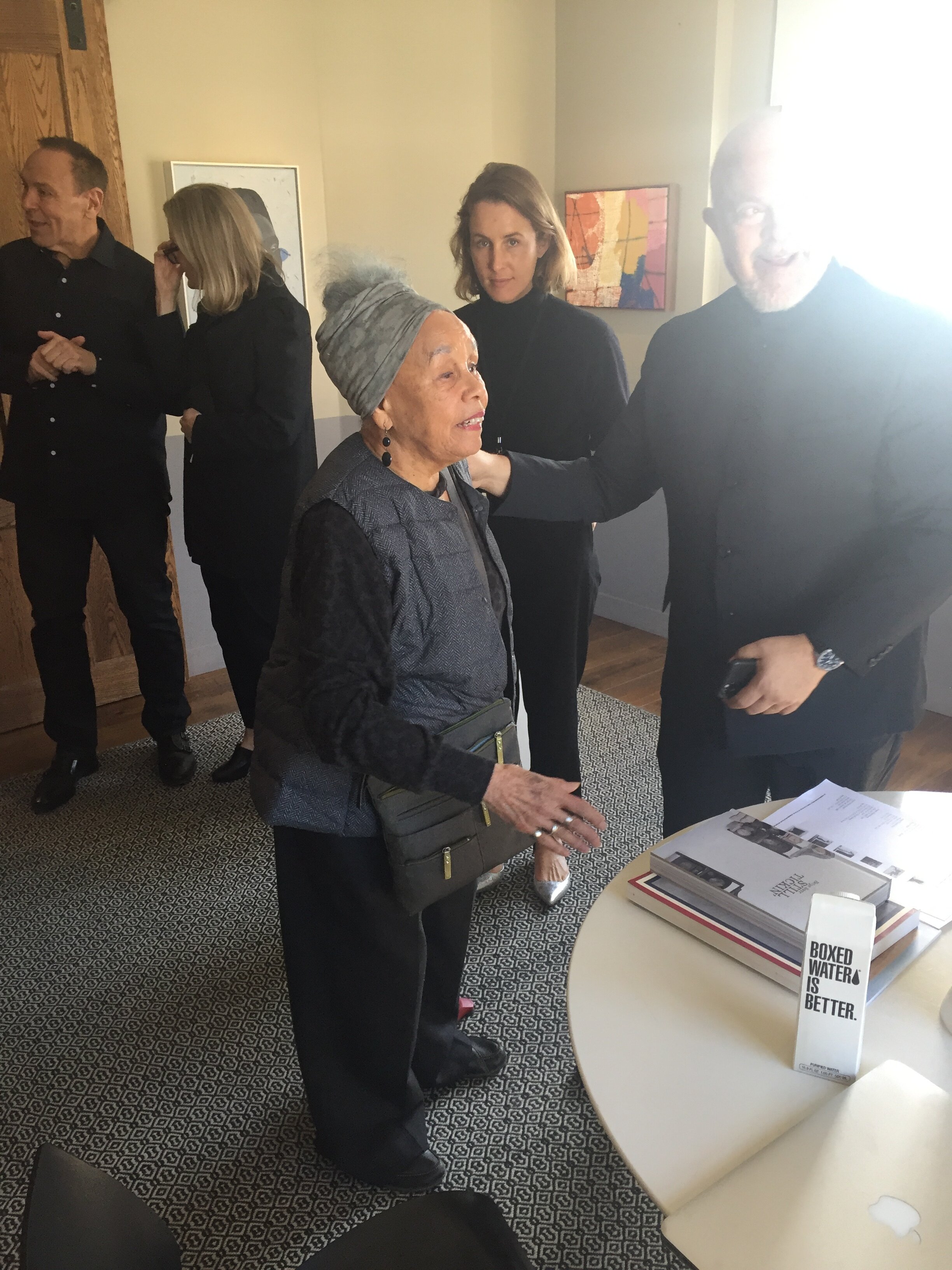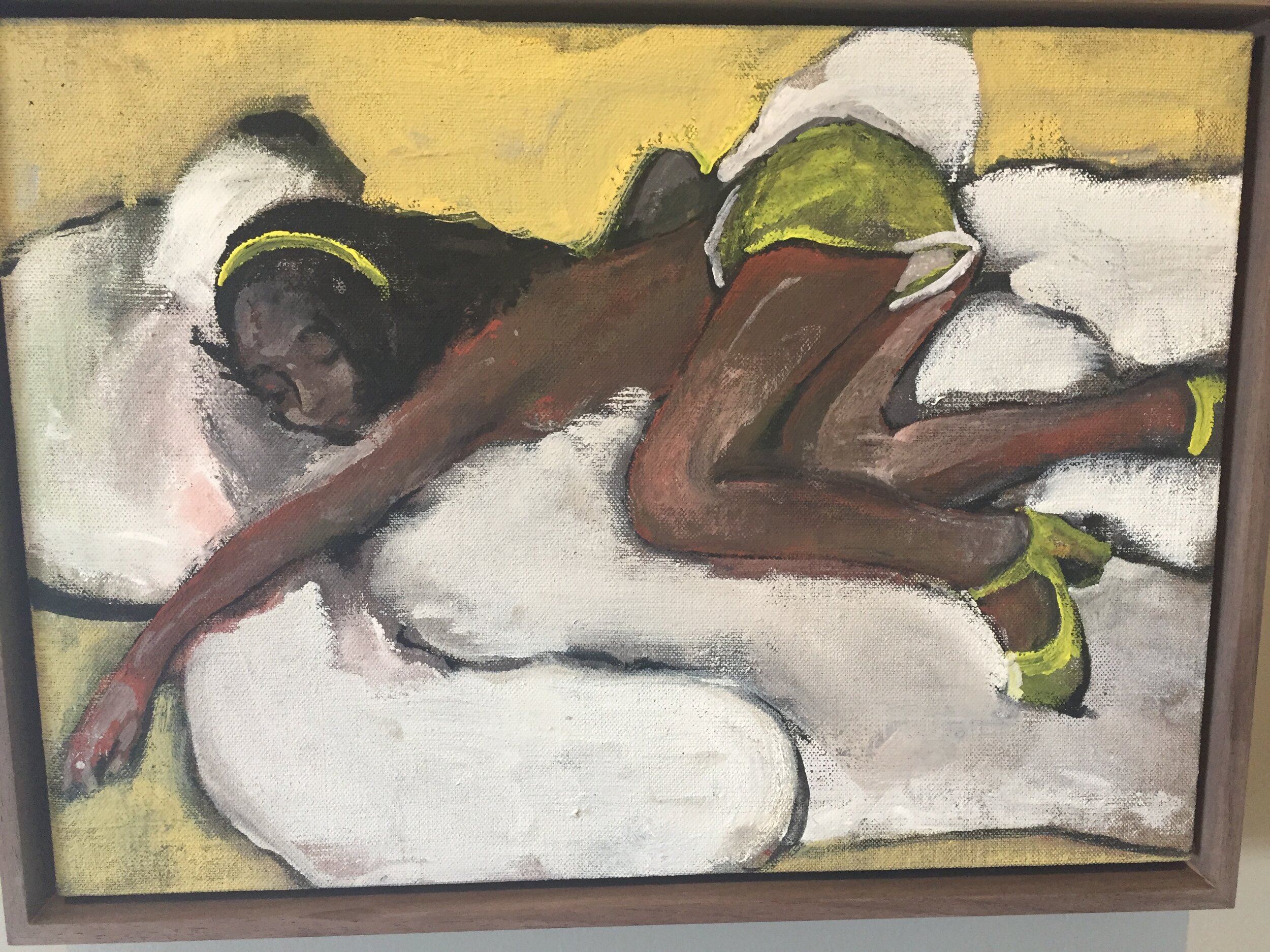Agnes Pelton, cut from similar luminous cloth as Hilma Af Klint, arrives at the Whitney in a time when meditative, transcendental work is a tonic. Though often lumped in with O'Keeffe she rightfully belongs to Water Mill, NY and Cathedal City, CA. She believed in a divine principal and portrayed emblems of higher planes of consciousness which we could all use right now. She worked alone, and was not known in her lifetime Here two example of her gauzy symbolist work. Go the Whitney website for more Pelton images now that the museum is alas closed.
Countryside-Rem Koolhaas on the hot seat
The reviews of Countryside have been unkinder than necessary. I found the vintage Technicolor graphics from China and Russia that Rem Koolhaas and team made into wallpaper, the undulating curtain with images that evoke the countryside from Marie Antoinette’s Hameau to Arcadia, inserts that ranged from hippie communes to gorillas, bathroom columns plastered with urban cowboys, Town and Country and Country Life magazine, Lego Sets and freestanding 19thcentury paintings a pleasurable and provocative riot of imagery and text (on the floor, walls and ceiling of the Guggenheim ramps). It was crowded and people were stopping to read, observe the plant life and tractor, watch the many videos. It’s as if Rem predicted that the Coronavirus would arrive and we would all want to flee into nature—which itself, he says is sorely compromised by climate change etc. It’s a perfect hike up the ramp into the Countryside. Go to the Guggenheim website for more images as alas the exhibition is now closed.
Gerhard Richter at the Met Breuer
The Gerhard Richter show will be the last of the Met's in the Breuer building. Next time your'e there it will be part of the Frick, a giant pop up now to different large neighboring institutions. It is a retrospective, yes, but I had trouble finding the 'there-there' . There are indeed some important works, more of the recent than earlier. but one sees a career that like Picasso's with its many style changes and different families takes some complementary narrative. Mysterious horizontal brush work is a unifying theme. Wall labels are all important as the show seems organized both by subject matter and period. It's impossible to get Florian Von Donnersmarck’s film Never Look Away out of your head which was the biopic that Richter cooperated with and then rejected but which did give some context to the life. There's a video on the Met website that is very good. These are my favorites. Go to the Met website for more images as the show is alas now closed.
Photos courtesy Met Breuer.
Le Corbusier's boat on the Seine in Paris
Did you know there was a Le Corbusier designed barge docked on the Seine in Paris? The boat was a project of the Comtesse Polignac and her friend Madame Zillhardt who gave the funds to the Salvation Army so they could better house the homeless. Corbu added pilotis, ribbon windows and a roof terrace. I'm not sure if our various agencies have ever considered refurbishing old boats as a solution to the homeless housing problem, but Corbu engaged in many socially conscious initiatives that had implications for the general population. The boat is currently being refurbished by a Franco-Japanese partnership after having sunk in 2018 when the Seine flooded. Quelle bonne idee!
A Race Against Time: one reporter's dogged pursuit of the Civil Rights murderers
Jerry Mitchell is the best kind of investigative journalist: his dogged and creative pursuit of his story-the Civil Rights assassinations of the sixties recounted in his new book Race Against Time— exposed murderers who had been hiding in plain sight. Michael Schwerner, along with James Chaney and Andrew Goodman became symbols of the bold crimes against the valiant who tried to help get out the vote in the south. That two were Jewish and one Black did not help their cause in racist Mississippi. Michael Schwerner's mom was our high school biology teacher. I often thought of her anguish and frustration as the Klansmen who had coldly plotted the murder were free for so long. Kudos to the plainspoken Mitchell for staying with it and helping to ferret them out.
Sam Wasson investigates the complex personalities that made Chinatown
Mourning the old Hollywood has become something of a cliché—yet there are some films that stand out for a kind of moviemaking in the seventies that no amount of Netflix or Amazon money can replicate: i.e. massive bets—many successful-- placed on talent without any assurance of box office returns. Chinatown was one of those adventures, not for the risk adverse. A producer, Robert Evans, whose eye for the sure thing was pegged to a sappy Love Story and the trilogy Godfathers; Robert Towne, a writer who struggled for years to get his story down; Roman Polanski, a Polish director who had made art films and Jack Nicholson, a star who held them together by sheer force of will and personality. All these come together in Sam Wasson’s granular, riveting history in his new book, The Big Goodbye. Wasson has them and close bystanders on the record. None remain untainted by cocaine and ego, but not enough to prevent Evans from digging his heels in and getting the movie done. Watch it again and be struck by how remarkably it holds up.
Noah Davis and Betye Saar, two lights shining on the black experience
Roberts Projects at Felix Fair in Los Angeles was the simultaneous sight of two pleasures. First: a tiny but lovely Noah Davis painting. Davis, who died tragically at 32, was a co-founder of the now defunct LA Underground Museum and a converted New Yorker. Collector Dean Valentine, co-founder of Felix, was one of his first collectors. He liked black architect Paul Williams (I once squatted for a few years in a classic Hollywood Williams manse) and was a cheerleader in general for the LA black artistic community. Another member of that cohort, 93 year old Betye Saar, came in and held my hand for at least two minutes while she warmly engaged in conversation about her recent show at MoMA, and how she still loves her work. (Zadie Smith has an excellent story about Kara Walker in the NYRB that speaks to some of this world) The juxtaposition of these two artists, one dead at 32, the other thriving at 93, was a tale in and of itself.
The Dolphin Letters: a study of writing and of love
Elizabeth Hardwick, Robert Lowell and Harriet Lowell, mid-1960s. Lowell was carrying this photo in his briefcase on the day he died in 1977. Photo courtesy FSG.
The recently published The Dolphin Letters, 1970-1979, those between writer Elizabeth Hardwick and her husband (then ex) poet Robert Lowell, and the small circle of intimates who were both their confidantes, close readers, and advisors (Mary McCarthy, Elizabeth Bishop, their publishers) are both profoundly moving and tragic and also uplifting in the way that only letters between such intelligent and self-aware people can be. Writer’s letters often function as alt-diaries, a way of learning what one thinks, but they also are uncommonly detailed and paint a portrait of a world less and less accessible in the age of internet.
Lowell and Hardwick were fine in between the many bouts of mania that hospitalized the poet over the years; the marriage of the southerner to the Boston Brahmin (though here revealed to have Jewish ancestors) was considered one of the pillars of the then very competitive, upper tier world of New York writers. Their daughter Harriet, at first depicted by Hardwick as pre-teen-y and difficult then comes into her own as she grows up in the shadow of Lowell’s coup de foudre—and subsequent marriage-- to Caroline Blackwood, a British beauty, heiress and writer who had already made other talented men (e.g.Lucian Freud, Bob Silvers) lose their heads. (See my recent post on the recent biography of Freud).
As the knowledge of the affair begun in England during a professorship Lowell takes, comes belatedly to Hardwick, she is devastated and lost. She writes to him, trying to hold onto him at first, and then slowly understanding the fullness of his attachment to this other compelling woman. We see her suffer deeply for a couple of years, and then gradually find her footing as an independent woman whose work—and daughter-- literally saves her life. Lowell reveals less as he keeps the details of his life with Blackwood from her for as long as he can but he is also stricken with guilt and confusion. Alongside the emotion are countless letters from Hardwick trying to grapple alone with their taxes and expenses and which takes over her life for extended periods. Friends McCarthy and Bishop—who are also close to Lowell--can only do so much to assuage her anguish.
Photo courtesy Harriet Lowell.
Compounding the torture is Lowell’s appropriation into his work, in particular his poem The Dolphin, of intimate details he culls directly from her letters. This fact is kept from her until it’s too late and the volume is published. The whole matter of how much writers are ‘allowed’ to capture from real life (this conversation generally around memoir today) is here fully fleshed out.
It brings round the subject of why publish these letters after all? Both Harriet Lowell and Blackwood’s children cooperated with this explosive volume—some would argue that sleeping dogs, children, wives and ex-wives should lie. For my part, I felt complicit at times in invading an intimacy to which I was not party, and yet anyone who has ever been rejected in love (and who hasn’t?) will feel a kinship with these two giants of literature who in the end had to sort through life as the rest of us must.
Deja vu all over again in Washington
Do you need an antidote to the White House of today? I just finished binging all seven seasons of the The West Wing. Yes, it scooped up many weeks, but boy was it worth it. As the impeachment, the campaigns, our policies foreign and domestic played out, there was the prescient series—that I had never really seen-- which eerily mirrored the mess of our time. Aaron Sorkin presented us with an insider view culled from real insiders like DeeDee Myers, Clinton’s press rep. I found myself smiling, crying, and impressed by the consistency of the writing and acting even if the signature ‘walking and talking’ made me want to strap Fitbits to the cast. If only.
Should Trump decide how our federal buildings look?
The White House has announced an executive order called "Making Federal Buildings Beautiful Again" which would establish neoclassical architecture as the default for all federal buildings, e.g., courthouses, post offices. Will MFBBA become an acronym like MAGA indicating a time when the country was falling under the sway of a despot who wanted to remake an imaginary US to his own personal taste? Now that Trump has been exonerated in the impeachment trial he feels free to attack another element in the culture wars: how our world looks. Does anyone remember when Prince Charles tried this? There are very good reasons to have contemporary architects pay attention to context but that doesn't mean they have to conform to a certain style. Its true mistakes have been made. But styles go in and out: a Paul Rudolph's Government Service Center in Boston, now endangered after being reviled for many years, is now newly beautiful in the eyes of many lovers of brutalism.
Kids City in Copenhagen
Copenhagen is at the top of the list of livable cities. Charming and also grand, the city is inviting and its citizens remarkably welcoming. Now the Danes are laying claim to the title of the city being the best place in the world for kids to live. Their deserved hubris is documented by a new exhibition at the Rem Koolhaas designed Danish Architecture Center. Kids City boasts slides and rides in a kind of real life Legoland and allows kids and grownups alike to understand the elements makes this creative metropolis work so well.
The Luxembourg Gardens host a temporary day care
The Luxembourg Gardens hold a special place in my heart. During my junior year abroad I had to cross the gardens on my way back and forth to the Rue Vavin every day, generally munching a croissant, in one direction, a chausson aux pommes in the other. The gardens are royal, the palace with its military guards is often the locus of art exhibitions, and are extremely well maintained. You can play tennis, or jog, or just take in the flowers and statuary on chairs and benches which are not fixed, moving them around as you like. There is never any trash on the ground. Now, a temporary nursery by Djuric Tardio Architects built with the modular concepts of Jean Prouve has been built in the gardens apparently to accommodate children whose own nurseries are under construction by the city of Paris. Though this feels odd in the midst of this royal splendor, all credit must be given to the French for prioritizing 'creche's' as the day cares are known, as they always do. The French are protesting losing their benefits which far exceed those of the US but in this case even a royal garden is enjoined in the quest for making the working lives of families possible. The building will stay in the Gardens for two years and then be moved to the 13th arrondissement. It took 5 months to build and cost around 2 million euros. Vive la France.
The mysteries behind Man Ray's Les Mysteres Du Chateau de De
In 1929 artist, photographer,filmmaker extraordinaire Man Ray was invited by one of his ardent patrons, the Vicomte de Noailles, and his infamous wife and partner in outlandishness, Marie-Laure, to their Robert Mallet-Stevens designed chateau in Hyeres, in the South of France, to shoot the house and its varying, dynamic collections as well as “make some of shots of his guests disporting themselves in the gymnasium and swimming pool,” according to Man Ray. As with many Surrealists who favored automatic writing, Man Ray favored a kind of automatic filmmaking. He looked upon film as another tool in his poetic, playful bag of tricks innovated with light but he had grown disenchanted as reality in the form of sound had begun to impose itself on the medium: improvisation was his preferred metier. Nevertheless, the Vicomte assured the artist that the film would be a documentary for their private viewing pleasure only, so Man Ray made an exception for the wealthy and generous man. Reminded of a Mallarme poem, “A throw of the Dice can Never do Away with Chance”, Man Ray decided to make, ‘chance’ the theme of the film. He brought with him two pairs of dice and six pairs of silk stockings which he intended to “pull over the heads of any persons that appeared in the film to help create mystery and anonymity.” Things being what they were at the Chateau, that is to say, already capricious with the beau mode in attendance, the film did not follow a neatly proscribed narrative.
Man Ray began shooting when he left Paris. Two men throw the dice, and leave for the south, arriving at the angular chateau—which is as much a character as anyone in the film. A couple throws the dice and decides to stay, then just as enigmatically to leave after another toss. Man Ray captured the right angles of the Mallet-Stevens modernist house, the painting archives, and eventually the frolicking guests shrouded in stockings and striped bathing suits as if in a phantasm. (Indoor gyms and exercise were all the rage in the late twenties; somehow the late nights and flamboyance had found a counterweight). The Vicomtesse appears in an underwater sequence with oranges in the glass-covered pool, a surreal Esther Williams; a stocking almost actually choked the Vicomte.
Les Mysteres du Chateau de De film also contains negative images akin to his signature Rayographs. This film was his last complete film. (By way of reference, the same year, Bunuel’s Un Chien Andalou was released).
The Gagosian Gallery in San Francisco has a very engaging show with good quality prints of Les Mysteres and two other films and numerous objets and stills drawn from the films as well as a short history of the house, now the Villa Noailles, an artists retreat. In a time when most films are literal-minded, these instead make the viewer a participant who is obliged to connect the dots—and the dice.
MAN RAY
Film Still from Le mystère du Château du Dé, 1929
Gelatin silver print
11 13/16 x 14 9/16 inches
30 x 37 cm
© May Ray Trust/Artists Rights Society (ARS), New York/ADAGP, Paris 2019
Image courtesy Gagosian Gallery
Charles Burchfield's landscapes still contemporary
Charles Burchfield was an artist who made lush, evocative, dare I say it, pretty paintings. But why are they so resonant? It feels like something is pulling at his trees from the bottom and top of the canvas, stretching them, that the colors he chose were not on the nose, that the scenes he depicted were drawn from reality and yet other-worldly. My mother, who was a Sunday-ish but accomplished painter did some work mostly influenced by him, and she was able to carry over this attenuated sensation. The retrospective I saw at the Hammer some years ago has stayed with me. I often see Burchfields for sale at tony art fairs as they do belong oddly enough on Park Avenue as much as Main Street, so elegant are his renderings.
The former home of a Pasadena collector goes Op
USC's Pacific Asia Museum in Pasadena has a more narrow focus than some of its other art venues. Yet Grace Nicholson, in whose 1924 home it now exists, was a kind of west coast version of Edith Halpert (Jewish Museum) collecting artifacts from Asia and the East and so its grounded in its collecting mandate. However: like many other institutions, USC is trying to draw online eyeballs. In turn, they have given Oscar Oiwa and four SC students 120 Sharpies to make a black and white grammable space. It looks very cool, cave-like, a bit sixties psychedelic and I look forward to seeing it.
Little Women for Adults
Little Women’s time shifts make it a narrative challenge at the outset but if you are patient with filmmaker Greta Gerwig, the characters of Meg, Jo, Beth and Amy become rich and rewarding individuals each grappling with the pleasures and pains of being young females. This new version breaks the fourth wall and has many of the hallmarks of auto fiction. For me Little Women was less about wanting to be Jo-although I did aspire to make my mark culturally and as a young woman (at the time as a performer)-and more about wanting a sister and the wholly different warm energy of lots of close females. I hope this G rated film will still find its way to adults who will find much to dig into. Oscars? I don’t know. But now , yes, finally I do want to be Jo, finding a way to write the things closest to my heart without fear of commercial validation.
Radical Women at the Wende Museum
Christine Schlegel is one of the artists in the Wende Museum’s (of the Cold War) current
exhibition The Medea Insurrection: Radical Women Artists Behind the Iron Curtain, drawn from the Dresden Albertinum’s more expansive show. While they remind of our own radical feminist artists of the earlier 70’s decade, these artists were living under more restrictive regimes in the still repressive Eastern bloc countries in the 80’s and appear in a delayed rebelliousness that was finally allowed to flourish. Schlegel’s practice was not just painting but extended to performance and postcards and the bonds that she formed with fellow East German artists gave heft to their individual work. This 1984 painting is of one of her dance collaborators Fine Kwiatkowski. The Wende is such an anomaly in LA where huge museums are constantly going up. Instead it surprises in the middle of Culver City with its tight focus and elegant gardens in the diminutive former home of the National Guard set up to fight Russia.
Queen and Slim is newest wave Bonnie and Clyde
How to describe the film Queen and Slim? Somehow Get Out meets Bonnie and Clyde doesn't do this black-is-beautiful-love-on-the-run-from-the-law story by tv writer Lena Waithe directed by music video director Melina Matsoukas, justice. A traffic stop gone wrong places the couple (Daniel Kaluuya and Jodie Turner Smith) in the close confines of a series of vehicles that turns their Tinder first date into a crescendo of vulnerability and true love. Commenting on the many wrongful deaths of black citizens while simultaneously showcasing an unusually vibrant and eccentric couple is a hat trick which the creative team pulls off in style and substance. Where this will fall in awards season is less important than that it is a female-driven release from a major studio--a rare exception in content and talent.
Lost Children Archive, the antidote to American Dirt
Valeria Luiselli though Mexican by birth is a global wanderer by upbringing and her empathy with childhood displacement is profound. Her story-or rather her multiple stories-tells of departures, journeys, searches: a family’s for a new life, a woman’s for an independent path, a man’s for fulfillment of an obsession, mother’s for their children, children for salvation in a new world, children for the attention of their own parents. Weaving these narratives in a novel which grows increasingly desperate and frightening in a scheme she rips both from the headlines of our border tragedies with Mexico and from Ovid, Virginia Woolf and Ezra Pound among others, she is deft stylistically and also heart wrenching. If you have time for one deep read in contrast to American Dirt, this should be it.
A playful Surrealist Lobster Hat at the Met Costume Institute
This hat, cherry red in the spirit of the season# and part of the Sandy Schreier collection now on view at the Costume Institute at the Met, was made by Benjamin Green-Field and his sister Bessie for their eponymous hat company Bes-Ben in 1941 (one way perhaps of avoiding prewar anti-Semitism was to add the hyphen?) Known as “the mad hatter of Chicago, it cannot escape notice that his lobster—y confection of surreal playfulness was in the spirit of Dali’s Lobster telephone now on view at MoMA.

